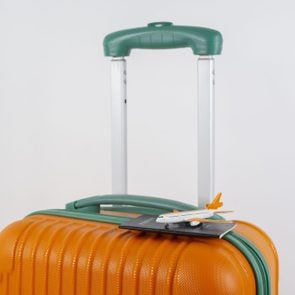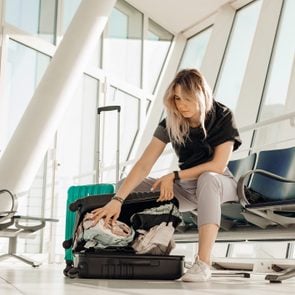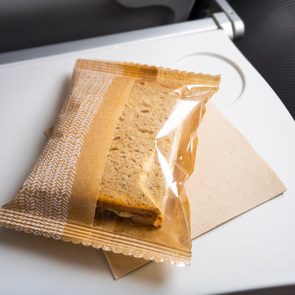This Is Why You Should Always Remove Those Small Baggage Stickers After Flying
Updated: Sep. 29, 2023
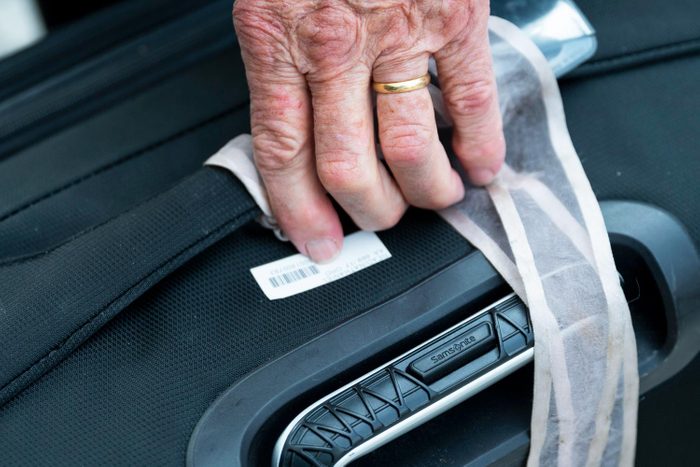
One simple mistake could send your bag on a very different trip than you intended
Losing your luggage while flying is the worst. We’ve all been there: You arrive at your destination only to discover your bag is nowhere to be found. Of course, you really needed the stuff you packed, but beyond that, you start stressing that your things will never make their way back to you. Even though lost luggage is often completely out of your control, especially at busy airports, you might be surprised to learn that isn’t always the case. In fact, sometimes it’s actually your fault.
According to a viral TikTok video currently making the rounds, the issue lies with those little baggage stickers on your luggage. You know, the ones about the size of a postage stamp. Things can go very, very wrong if you forget to remove the old ones on your bags before your next flight. Here’s what you need to know about those stickers—and how to prevent this frustrating mishap.
Get Reader’s Digest’s Read Up newsletter for more travel, tech, humor, cleaning and fun facts all week long.
What happens if you don’t remove those small baggage stickers?
@flyontairport Pro Tip: If you dont want your bags to get lost when traveling… remove old stickers from past trips off your luggage. #FlyONT #SoCalSoEasy ♬ Sunshine – WIRA
In a video recently shared to TikTok by Ontario International Airport in California, an airport worker explains it can be a huge problem when you don’t remove those baggage stickers. “Let’s say you flew American, and then a month later, you flew Southwest,” he says. “Well, there’s a little sticker that goes on for American that tells the computer that it should go there.”
Pointing to a newly affixed sticker, he continues, “So if your month-old American sticker is on there, there is a chance it scans instead of this one.” The result? Your bag doesn’t make it onto your flight—and instead ends up at the airline’s unclaimed baggage center, before heading to the airport’s lost and found.
That old sticker also pertains to the airline you flew previously, which can complicate things further. To use the example in the video, if you’re now flying Southwest but your old sticker says American, your bag might end up in the American terminal, making it that much harder to track down your missing bag.
What information is on those baggage stickers, exactly?
A lot of very specific information that ensures your bag arrives with you at your destination. Baggage stickers contain barcodes that link the bag to the individual traveler and airline ticket, as well as details about your airline, flight and date of travel. While their original purpose is to provide a backup solution in case the main tag gets damaged or lost, the barcode on the sticker can be scanned to get details about your bag or reprint the main tag if necessary. These stickers get scanned first by the agent when you check your bag, then by baggage handlers throughout your journey, so they know where to direct it. Even if the first person scans the correct tag, the second one might scan a rogue sticker and mayhem could ensue.
Even seasoned travelers can make this mistake
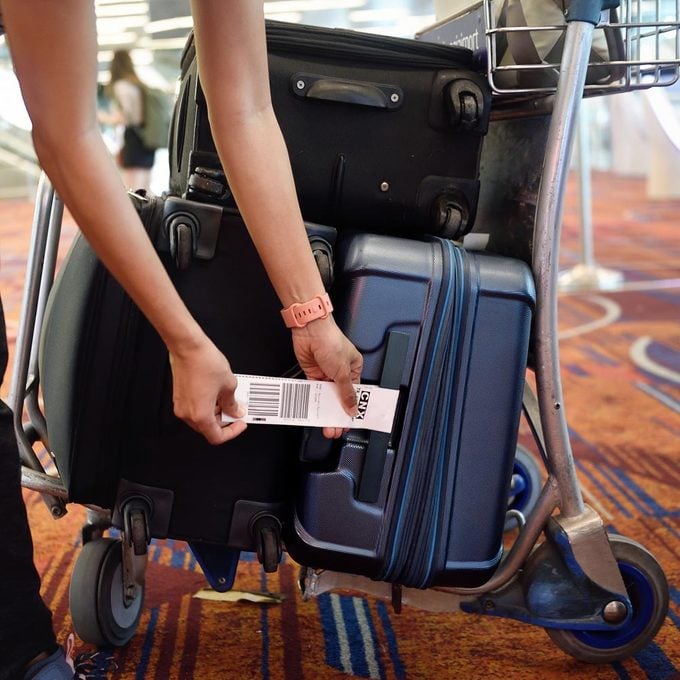
This past summer, frequent flier Harvey Silikovitz became a member of the prestigious Travelers Century Club, an organization for travelers who have visited more than 100 countries and territories around the world. Despite a lifetime of travel, Silikovitz found himself in this exact situation when he returned home to New York after a trip to Chicago.
He checked his bag at Chicago’s O’Hare Airport before boarding his New York–bound flight, but neglected to take off the old stickers from his original flight to Chicago. The agent at the gate didn’t remove them either, and Silikovitz never thought to check. “Usually they will remove the stickers, but if you leave them on, you take the risk that they won’t,” he explains. “They scanned my old sticker, which had a destination of Chicago.”
Once he got to New York, he couldn’t find his bag … and even more concerning, the airline had no record of his bag ever being scanned. “I called up the airline and said, ‘What would happen if it went on to the conveyor belt with the original stickers on it, rather than the ones that should have been placed on the bag so that it could be loaded onto my outbound flight?’ And it was exactly what had happened. Unbeknownst to me, my bag ended up [back] at O’Hare!”
Luckily, Silikovitz wasn’t without his bag for long, but that might not have been the case if he hadn’t asked that question. “If I hadn’t had the presence of mind to call them and say ‘Could this have happened?’ who knows how much time would have gone by?” He also had his contact information on his bag, which helped the airline workers identify it quickly once he spoke to someone.
How can you prevent this from happening to you?
Fortunately, this is an easy problem to avoid. “Get into the habit of removing the sticker,” says Silikovitz. “Do it either when you get to where you’re staying at your destination or, even better, as soon as you retrieve your bag.”
Beyond that, here are a few additional steps you can take:
- When you check your bag, make sure the agent gives you a baggage claim sticker—and hang on to it. (Sometimes you’ll receive your baggage claim sticker with your printed boarding pass, but if you’re using a mobile boarding pass, the agent will simply hand it to you.)
- Make sure the agent puts the new sticker on your luggage.
- Use the airline app to track the status of your bag.
If you do lose your bags despite your best efforts, here’s what you need to know about being reimbursed for your lost luggage. FYI, those rules also apply if your luggage is damaged or delayed, so you’ll definitely want to bookmark that information, just in case.

